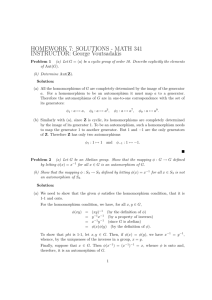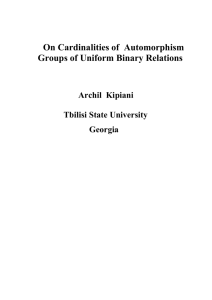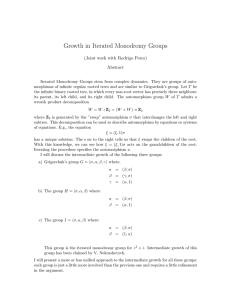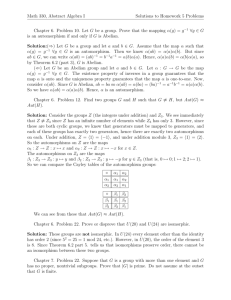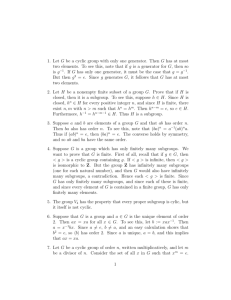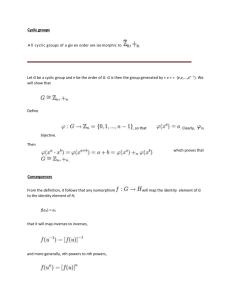THE GROUP OF AUTOMORPHISMS OF A 3-GENERATED 2-GROUP OF INTERMEDIATE GROWTH
advertisement
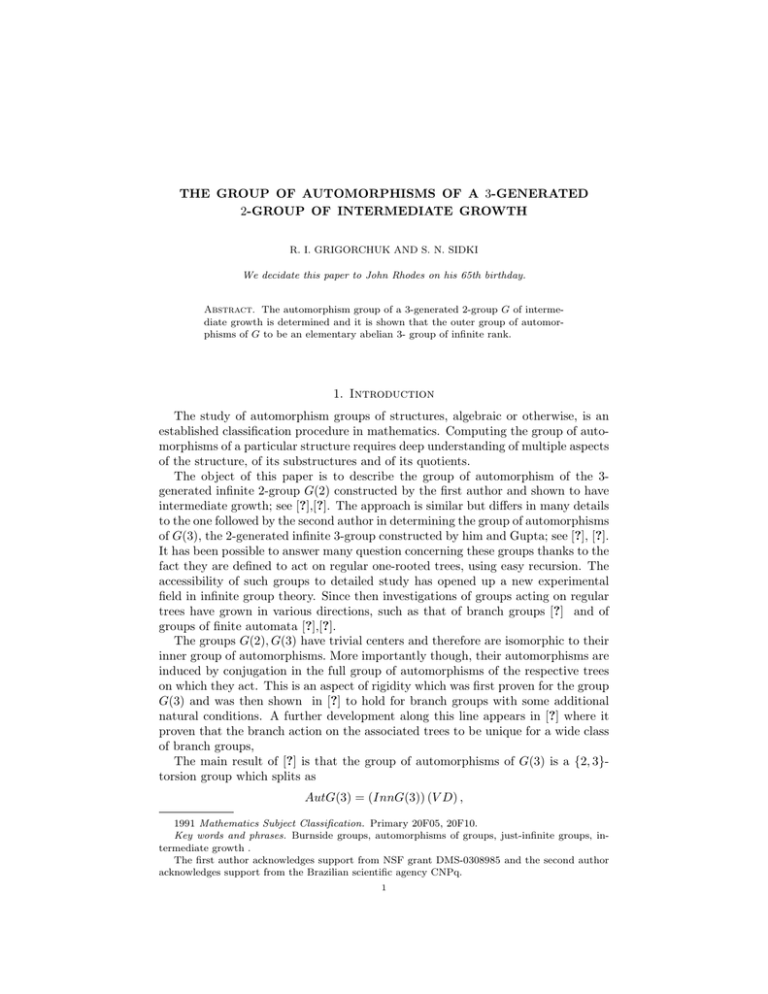
THE GROUP OF AUTOMORPHISMS OF A 3-GENERATED
2-GROUP OF INTERMEDIATE GROWTH
R. I. GRIGORCHUK AND S. N. SIDKI
We decidate this paper to John Rhodes on his 65th birthday.
Abstract. The automorphism group of a 3-generated 2-group G of intermediate growth is determined and it is shown that the outer group of automorphisms of G to be an elementary abelian 3- group of infinite rank.
1. Introduction
The study of automorphism groups of structures, algebraic or otherwise, is an
established classification procedure in mathematics. Computing the group of automorphisms of a particular structure requires deep understanding of multiple aspects
of the structure, of its substructures and of its quotients.
The object of this paper is to describe the group of automorphism of the 3generated infinite 2-group G(2) constructed by the first author and shown to have
intermediate growth; see [?],[?]. The approach is similar but differs in many details
to the one followed by the second author in determining the group of automorphisms
of G(3), the 2-generated infinite 3-group constructed by him and Gupta; see [?], [?].
It has been possible to answer many question concerning these groups thanks to the
fact they are defined to act on regular one-rooted trees, using easy recursion. The
accessibility of such groups to detailed study has opened up a new experimental
field in infinite group theory. Since then investigations of groups acting on regular
trees have grown in various directions, such as that of branch groups [?] and of
groups of finite automata [?],[?].
The groups G(2), G(3) have trivial centers and therefore are isomorphic to their
inner group of automorphisms. More importantly though, their automorphisms are
induced by conjugation in the full group of automorphisms of the respective trees
on which they act. This is an aspect of rigidity which was first proven for the group
G(3) and was then shown in [?] to hold for branch groups with some additional
natural conditions. A further development along this line appears in [?] where it
proven that the branch action on the associated trees to be unique for a wide class
of branch groups,
The main result of [?] is that the group of automorphisms of G(3) is a {2, 3}torsion group which splits as
AutG(3) = (InnG(3)) (V D) ,
1991 Mathematics Subject Classification. Primary 20F05, 20F10.
Key words and phrases. Burnside groups, automorphisms of groups, just-infinite groups, intermediate growth .
The first author acknowledges support from NSF grant DMS-0308985 and the second author
acknowledges support from the Brazilian scientific agency CNPq.
1
2
R. I. GRIGORCHUK AND S. N. SIDKI
where V is an elementary abelian 3-group of infinite rank and D is elementary
abelian of order four which normalizes V .
We will show in this paper that the group of automorphisms of G(2) is a 2-group.
More precisely. we will prove
Theorem 1. The group G(2) admits an infinite set of automorphisms of order
2 which generate a group V such that AutG(2) = (InnG(2)) V and OutG(2) is
elementary abelian 2-group of infinite rank.
2. Preliminaries
2.1. The binary tree and its automorphisms . The binary tree, denoted by
T , has as its vertices all finite strings u with entries 0, 1, with the ordering defined
by v < u provided u is an initial sequence of v. Each vertex u is the root of
a subtree Tu whose vertices are all strings with prefix u. Let A be the group
of automorphisms of T and let a be the automorphism of T which interchanges
the vertices 0u and 1u for each string u. Using the natural isomorphism between
T and its subtrees T0 , T1 we may represent any x ∈ A as x = (x0 , x1 )ai , where
x0 , x1 ∈ A and i ∈ {0, 1}. In this manner the group A is identified naturally with
the wreath product AwrC2 of A by the cyclic group C2 of order two. Thus, in
this representation, the identity element 1 ∈ A is 1 = (1, 1)a0 . The automorphisms
x0 , x1 have similar ‘developments’ in terms of certain x00 , x01 , x10 , x11 ∈ A, and so
on.
Given x ∈ A, then define the following elements of A: x(0) = x, x(1) = (x, x)
and recursively x(i) = (x(i−1) )(1) for all i ≥ 1.
The nth level stabilizer stH (n) of a subgroup H of A is the kernel of the action of
H on the strings of length n. For every string u of length n, the elements of stA (n)
induce automorphisms of the tree with root u; thus we obtain the projection map
πu : stA (n) → A. Given a subgroup H of A, for each vertex u we write u ∗ H for
the subgroup of A which induces H on the subtree Tu and acts trivially outside
this subtree. The group generated by all subgroups u ∗ H with u of length n is
of course the direct product of these subgroups and we denote it by ×2n H. Any
subgroup or element of H outside stH (1) is called active.
For any subgroup H of A, the rigid stabilizer ristG (u) of u in G is the subgroup
H ∩ (u ∗ A). For each n ≥ 0 we write ristH (n) for the group generated by all
subgroups ristH (u) with u of length n.
A subgroup H of A is called a branch group if for all n if it acts transitively
on the set of nth level vertices (that is, the vertices which are strings of length n)
and if ristH (n) has finite index in G. As was proven in [?], a branch group is just
infinite provided ristG (u) has finite abelianization.
2.2. The group G(2). The group G = G(2) is generated by the three automorphisms a, b, c of the tree T where b, c are defined recursively by
b = (a, c), c = (a, d), d = (1, b);
note that d = bc and a2 = b2 = c2 = d2 = 1. In this section we will give a summary
of some known facts about G (see: [?], [?]) and will prove some new ones which
will be necessary to reach our main result.
AUTOMORPHISMS OF A 2-GROUP
3
Denote by H the 1st level stabilizer stG (1). Then H is a normal subgroup of
index 2 in G and is generated by the four elements
c, d, ca = (d, a), da = (b, 1);
the symbol xy denotes y −1 xy, the conjugate of x by y. Thus, H is a subdirect
product of G × G and G is a subgroup of (G × G) < a >.
2.2.1. Length and Depth Functions. Let |g| denote the length of g with respect to
the system of generators a, b, c, d. Any shortest word representing g has the form
∗a ∗ a... ∗ a∗
where ∗ denotes an element from the set {b, c, d}, yet the first and last ∗ can
be the empty word. Let g ∈ G and write its representation on the tree as g =
(g0 , g1 )aε , g0 , g1 ∈ G, ε = 0, 1. Then |gi | ≤ 21 (|g| + 1). If the first or last ∗ is empty
then the inequality improves to |gi | ≤ 12 |g|; see [?].
There is a level k of the tree such that in the development of g, its states gu ∈
{1, a, b, c, d} for all strings u of length k. The smallest such k is called the depth of
g and is denoted by depth(g). From the inequalities for the length function we get
depth(g) ≤ log2 (|g|) + 1.
Proposition 1. The group G is an infinite 2-group.
The proof follows simply by induction on the word length.
2.2.2. Special subgroups. (i) From the definition of the generators, b = (a, c), c =
(a, d), d = (1, b), we calculate
2
2
2
(ab) = (ca, ac), (ac) = (da, ad), (ad) = (b, b) = b(1) ,
4
(2)
(ac) = b ,
8
(ab) = b(3) ,
[b, b(2) ] = (1, ([a, b], 1)).
(ii) We have the dihedral groups:
< a, b > of order 32, < a, c > of order 16, < a, d > of order 8.
(i) Let B, C, D be the normal closures in G of < b >, < c >, < d >, respectively.
Then G factorizes as the following semidirect products
G = C < a, d >= D < a, c >= B < a, d >.
(iii) Rigid stabilizers. The 1st restricted stabilizer is ristG (1) = D = B × B.
2
Define K =< (ab) >G . Then, K = [B, G], [D, H] = K × K and hthe quotient
i
2
group G/K = K < a, d > +K < b > is finite of order 16. Since (ab) , d =
2
(1, (ab) ), it follows that
2
K = (K × K) < (ab) > and thus, [K, D[= K × K. Inductively we produce the
series G > K > K × K > ... > ×2m K > ... of normal subgroups of G. It is clear
that ristG (m) ≥ ×2m K for m ≥ 1.
Proposition 2. The group G is just-infinite and not abelian-by-finite.
Proof. Since G is a torsion branch group and ristG (m) has finite index in G, it
follows that G is just-infinite. Also, G is not abelian-by-finite, for otherwise it
would finite.
8
(3)
(i+3)
We note that (ab)
∈ ×2m K for all i. Also,
= (b)
ca ∈ K implies that (b)
2
4
2
2
2
2
we conclude (ac) ≡ (ad) modulo K, (ac) ≡ (ab)4
from (ac) (da) = (ab)
modulo K × K.
4
R. I. GRIGORCHUK AND S. N. SIDKI
(iv) The group G has 7 subgroups of index 2 (see [?]). These are:
J(0, 2) =< a, b >G =< a, ac , b >,
J(0, 3) =< a, c >G =< a, ad , c >,
J(0, 4) =< a, d >G =< a, ab , d >,
J(0, 5) =< b, ac >G =< b, ac >,
J(0, 6) =< c, ab >G =< c, ab >,
J(0, 7) =< d, ab >G =< d, ab >,
J(1, 2) = H = stG (1) =< c, ca , d.da >= D < c, ca >.
The group J(0, i) ∩ H is a subdirect product of G × G for i = 2, 3, 5, 6, and
J(0, i) ∩ H is a subdirect product of J(0, 5) × J(0, 5) for i = 4, 7. Furthermore,
B is a subdirect product of J(0, 3) × J(0, 3), and C is a subdirect product of
J(0, 4)×J(0, 4). The first three groups in the list are not 2-generated, the next three
are not cyclic and the last one which the group H is not 3-generated. Therefore,
H is a characteristic subgroup.
2.2.3. Centralizers. (i). If N be a normal non-trivial subgroup of G, then CG (N ) is
trivial. Otherwise, N ∩ CG (N ) = Z(N ) has finite index in G and thus G is solvable
and finite; a contradiction.
(ii) Suppose X ≤ B is nontrivial such that U = X × {1} is normal in H. It is
clear that CG (U ) ≤ H. Let(w, v) commute with U , then w commutes with X and
therefore w = 1. Thus, CH (U ) = 1 × B.
(iii) Let W, V be commuting normal subgroups of H. Then, W ≤ B × {1}, V ≤
{1} × B or vice versa:
if W ∩ (B × {1}) is trivial then W is contained in the centralizer of B × {1} and
therefore is contained in {1} × B; if W ∩ (B × {1}) = X × {1} is non-trivial then,
by (ii), its centralizer is equal {1} × B and therefore V ≤ {1} × B.
4
(iv) The centralizer of a in G factorizes as CG (a) = {(v, v)|v ∈ B} < (ac) ><
a >. For, CG (a) = CH (a) < a > and since H = (B × B) < c, ca >, given
i
i
x ∈ CH (a), there exist u, v ∈ B, i, j ≥ 0 such that x = (u, v) (ad) aj , (da) dj
i
i
and u (ad) aj = v (da) dj ..
Proposition 3. ([?] ) The centralizer CG (a) is finitely generated and if an element
g ∈ G has finitely generated centralizer, then g is conjugate to a.
2.2.4. Decomposable groups. (i) The following result about groups decomposed as
sums of indecomposable subgroups implies that their automorphisms permute the
indecomposable factors.
Proposition 4. Let U be a group with trivial center which decomposes as U =
U1 ⊕ U2 ⊕ ... ⊕ Us = W1 ⊕ W2 ⊕ ... ⊕ Wt where Ui , Wj are indecomposable normal
subgroups of U. Then, {U1 , U2 , ..., Us } = {W1 , W2 , ..., Wt } and s = t.
Proof. Let pi be the projection of U onto Ui . Then < pi (Wj )|1 ≤ j ≤ t >=
Ui , [pi (Wj ), pi (Wk )] = 1 for j 6= k and as Ui has trivial center, Ui = pi (W1 ) ⊕
pi (W2 ) ⊕ ... ⊕ pi (Wt ). Since Ui is indecomposable, there exists a unique j = f (i)
such that Ui = pi (Wj ) and pi (Wk ) = 1 for all k 6= j. Thus f is injective and
by the symmetry between the two decompositions of U we get that f is bijective
and thus, s = t. We may rearrange indices so that f is the identity function and
so Ui = pi (Wi ) , pi (Wk ) = 1 for all k 6= i. Hence, Ui = pi (Wi ) = Wi for all i. AUTOMORPHISMS OF A 2-GROUP
5
(ii) The group G = G(2) is indecomposable. For, suppose G = U + V for some
subgroups U, V . Then U ∩ V is a central subgroup and is therefore trivial. Hence
either U or V has finite order and is therefore trivial.
(iii) Let R be subgroup of H which projects onto G in both coordinates. Then
R is indecomposable. For, suppose R = U + W . Then G = πi (U ) + πi (W ) and
so either πi (U ), πi (W ) is trivial. Say π0 (U ) = 1, π0 (W ) = G then π1 (U ) = G and
π1 (W ) = 1; thus, G × G ≤ R and R = H. It follows that H = G × G. and G is
infinitely generated; a contradiction.
(iv) The subgroups H and J(0, i) ∩ H are indecomposable for i = 2, 3, 5, 6 by
(iii) and 2.2.2.
(v) Let M be any one of the maximal subgroups J(0, i) for i = 2, 3, 5, 6. Then
M is indecomposable. Suppose the contrary and let M = U + W for some U, W ≤
M . If U ≤ H then M ∩ H = U + (W ∩ H) and by (iii), W ∩ H = 1; thus W
has order 2; a contradiction. Hence U and W are not contained in H. Now let
UH = U ∩ H, WH = W ∩ H. We consider the intersection of UH and WH with
K × K. Now K × K ≤ M ∩ H and is normal in H. Let UH ∩ (K × 1) = K̇ × 1.
If K̇ 6= 1 then CG (K̇ × 1) ≥ W ; but this absurd since W is active..Thus K̇ = 1.
Now, since UH and K × 1 are both normal in M , it follows that UH centralizes
K × 1 and π0 (UH ) centralizes K. Since K is a normal subgroup of G, it follows
that π0 (UH ) = 1. By symmetry, we have π1 (UH ) = 1. Hence UH = 1, o(U ) = 2
and U G is a finite group; a contradiction.
(vi) The subgroup B is indecomposable. This is so since B is a subdirect product
of J(0, 3) × J(0, 3) and a decomposition of B induces a decomposition of J(0, 3).
(vii) The subgroup D is characteristic in G: the image of D = ristG (1) = B × B
under an automorphism of G is a subgroup of H decomposable as a direct sum of
two normal subgroups of H and so, the result follows by an application of item (iii)
of 2.2.3.
3. Proof of the main result
Let A denote Aut(G), the automorphism group of G. Since the center of G is
trivial, we identify G with its group of inner automorphisms Inn(G). By Proposition 3, the conjugacy class of a in G is a characteristic subset of G. Therefore,
given τ ∈ A, on composing it with a conjugation by some h ∈ H, we may assume
that τ fixes a. Denote the subgroup of automorphisms which fix a by Aa . Since
D = B × B is a characteristic subgroup of G and B is indecomposable, τ permutes
{B × 1, 1 × B}. We may suppose that τ leaves both B × 1, 1 × B invariant; if not,
then we modify τ to τ a. Recall π0 , π1 the projections of H onto G. Then, as H is
a characteristic subgroup of G, we have that τ π0 , τ π1 are homomorphisms from H
onto G. If h ∈ H is in the kernel of τ π0 then hτ ∈ 1 × B = ker(π0 ) and so h ∈ 1 × B
Therefore, for i = 0, 1, the maps hπi → hτ πi define automorphisms τi of G. Hence,
τ restricted to H is induced by the automorphism (τ0 , τ1 ) of G × G and as τ commutes with a, we have τ0 = τ1 . We conclude that a general automorphism τ of G
is a restriction of an automorphism of the overgroup (G × G) < a >, having the
form (σ, σ) hai for some σ ∈ Aut(G), h ∈ H, i = 0, 1. A unique form τ = (σ, σ) hai
can be obtained where i = 0, 1 and h is an element from a fixed right transversal
2
S of CH (a) = {(u, u)|u ∈ B < (ad) >} in H. Since σ can be developed similarly we obtain sequences τ (m) ∈ Aut(G), h(m) ∈ S and i(m) ∈ {0, 1} defined by
τ (0) = τ, h(0) = h, i(0) = i and inductively, τ (m) = (τ (m + 1), τ (m + 1))h(m)ai(m) .
6
R. I. GRIGORCHUK AND S. N. SIDKI
This development of τ shows that for all k ≥ 1, it is the restriction of an automorphism of (×2k G)P (k) to G, where P (k) is a Sylow 2-subgroup of Sym(2k ). Hence,
stG (k) is τ -invariant for all k ≥ 1. Now, the sequences h(m), i(m) determine the
following well-defined infinite product of automorphism of the tree
(m) (1)
α = ... h(m)αi(m)
... h(1)αi(1)
h(0)αi(0) .
−1
Clearly, α is an automorphism of the tree, and g −1 (g)ατ ∈ stG (k) for all k ≥ 1
and all g ∈ G. As ∩k≥1 stG (k) = 1 we conclude that α = τ . We have shown
Proposition 5. The group A = Aut(G) is isomorphic to NAut(T ) (G).
3.1. Some outer automorphisms. Define the automorphism of the tree θ(0) =
(ad, ad) = (ad)(1) of ×2 G and define for all i ≥ 0, θ(i) = (ad)(i+1) ∈ ×2i+1 G. Let
V = {θ(i)|i ≥ 0}. We calculate
[θ(i), a] = 1,
d
[θ(0), c] = (ad)(1) , c = ([ad, a] , [ad, d]) = ([d, a] , [a, d] ) = b(2) ,
d
[θ(0), d] = (ad)(1) , d = (1, [ad, b]) = (1, [a, b] ) ∈ ×2 K,
d
[θ(1), c] = ([θ(0), a] , [θ(0), d]) = (1, (1, [a, b] )) ∈ ×22 K,
d
[θ(1), d] = (1, [θ(0), b]) = (1, [θ(0), cd]) = (1, [θ(0), d] [θ(0), c] ) ∈ ×22 K.
By induction on i, we have
[θ(i + 1), c] = (1, [θ(i), d]) ∈ ×2i+2 K,
[θ(i + 1), d] = (1, [θ(i), b]) ∈ ×2i+2 K.
Therefore, θ(i) ∈ N (G) in ×2i+1 G. Now, θ(0) = (ad)(1) ∈ ×2 G\G; otherwise,
(ac)−2 (ad)(1) = (ad, 1) ∈ H and ad ∈ B ≤ H, which is absurd. Also, θ2 (0) =
2
2
((ad) , (ad) ) = b(2) ∈ G. Similarly, θ(i) ∈ ×2i+1 G\ ×2i G. We have shown that
V ⊂ NA (G)\G, V 2 ⊂ G and that modulo G, the set of θ(i)’s are independent.
Since ca c = (da, ad) ∈ G, the automorphisms θ(0) = (ad, ad) can be modified
2
modulo G to µ = (da, ad)(ad, ad) = (1, (ad) ) of order 2. Similarly, we produce the
(i)
outer automorphisms µ(i) = (ca c) θ(i) for i ≥ 0 where µ(0) = µ. It is clear that
{µ(i)|i ≥ 0} generate V modulo G.
Lemma 1. Let y = (g)(m) ∈ ×2m G, m ≥ 1. Then y normalizes G if and only if
g ∈ B < ad >.
(m)
Proof.
Observe
does not normalize G, since
that (a)
2
(m)
c, (a)
= (1, (1, .., (1, (da) ))...) ∈
/ G. Also, we know (b)(m) ∈ G and θ(m −
(m)
1) = (ad)
normalizes G. Now the proof follows from G = (B < ad >) < a >. 3.2. The final step. We start with
Lemma 2. Let (τ, g) be a pair with τ ∈ A, g ∈ G such that xτ = xg for x ∈ {b, c, d}.
Then τ is an inner automorphism.
Proof. We will first prove the assertion for the pair (τ, g) with τ ∈ Aa . Write
(1)
τ = (σ, σ)hai in its normal form. Then since τ fixes a, we have h = (h0 ) . Suppose
we have a counterexample (τ, g) with g of minimal length. Then, |g| = n > 1 and
that the minimal word representing g has the form a ∗ a ∗ a...a∗ where the last
∗ may be empty. It is clear that g ∈ H if and only i = 0. The length of g
is even; for otherwise, the form of g ends
in 0 a and
g is active and so a can be
cancelled from both τ and g. Then, bτ = aσh , cσ = bg = (ag0 , cg1 ) and therefore
AUTOMORPHISMS OF A 2-GROUP
0
0
7
0
aσh = ag0 , cσh = cg1 . Similarly, we obtain dσh = dg1 , bσh = bg1 . Let σ 0 = σh0 g0−1
and g 0 = g1 g0−1 . Therefore, the pair (σ 0 , g 0 ) satisfies the hypothesis and σ 0 fixes a.
From 2.2.1, |gi | ≤ 12 (|g| + 1) for i = 0, 1 and as |g| is even, |g 0 | ≤ |g|. Then
0
|g | = |g| and since the first coordinate of d is the identity 1, we conclude that d
cannot occur as one of the ∗ symbols in the form of g. We repeat the process to the
pair (σ 0 , g 0 ) producing (σ 00 , g 00 ). Then |g 00 | = |g| and we find that d cannot occur as
one of the ∗ symbols in the form of g 0 = g1 g0−1 ; therefore c cannot occur as one of
the ∗ symbols in the form of g. One more repetition of the process eliminates the
occurrence of b in the form of g as well and we reach a contradiction.
In the general case, where τ may not fix a, we have aτ = ay for some y ∈ G and
thus we simply apply the previous case to the pair (τ y −1 , gy −1 ).
Since bτ , cτ , dτ have finite depth, there exists a level m such that (bτ )u , (cτ )u , (dτ )u ∈
{1, a, b, c, d} for all strings u of length m. We observe from
ai(0)
ai(0)
ai(0)
bτ = aτ (1)h(0)0 , cτ (1)h(0)1
, cτ = aτ (1)h(0)0 , dτ (1)h(0)1
, dτ = 1, bτ (1)h(0)1
that for each level k there exist a string u of length k and y ∈ G such that
τ (k)y
{(bτ )u , (cτ )u , (dτ )u } = {b, c, d}
. Hence for the level m, there exists y 0 ∈ G
0
such that for γ = τ (m)y , we have {b, c, d}γ = {b, c, d}. Since D is a characteristic
subgroup of G, it follows that dγ = d and {b, c}γ = {b, c}. Now, γ = (γ0 , γ1 ) for
some γ0 , γ1 ∈ Aut(G). Suppose bγ = c. Then bγ = (aγ0 , cγ1 ) = (a, d) and therefore
cγ1 = d which is impossible. Hence, γ fixes b, c, d. It follows from the previous
lemma that τ (m) is conjugation by some q ∈ G. Since, τ = τ (m)(m) g for some
g ∈ G, we have q (m) normalizes G. By Lemma 1, q ∈ GV . This concludes the proof
of the main theorem.
References
[1] Ceccherni-Silberstein, T. G., Scarabotti, F., Tolli, F., ”The top of the lattice of normal
subgroups of the Grigorchuk group”, J. of Algebra 246, (2001), 292-310.
[2] Grigorchuk, R. I. , ”On Burnside’s problem on periodic groups”, Functional Anal. Appl. 14
(1980), 41-43.
[3] Grigorchuk, R. I. , ”Degrees of growth of finitely generated groups and the theory of invariant
means”, Izv. Akad. Nauk SSSR 48 (1984), no.5, 939-985.
[4] Grigorchuk, R. I. , Just infinite branch groups, In: New horizons in pro-p groups, Birkhauser
(M. P. F. du Sautoy, D. Segal and A. Shalev eds) (2000), 121-179.
[5] Grigorchuk, R. I. , Nekrashevych, V. V. , Sushchansky, V. I., ”Automata, Dynamical systems
and Groups”, Proceedings of the Steklov Institute of Mathematics (2000), 134-214.
[6] Grigorchuk, R. I. , Wilson, J. S. , ”The uniqueness of the action of certain branch groups on
rooted trees”. To appear in Geomtria Dedicata.
[7] Gupta, N, Sidki, S, ”On the Burnside problem for periodic groups”, Math. Z. 182 (1983),
385-388.
[8] de la Harpe, P., Topics in geometric group theory. Univ. of Chicago Press (2000).
[9] Lavreniuk, Y., Nekrashevych, V., ”Rigidity of branch groups acting on rooted trees”, Geometria Dedicata 89 (2002), 159-179.
[10] Rozkhov, A. V. , ”Centralizers of elements in a group of tree automorphisms”, Russian Acad.
Sci. Izv. Math. 43 (1994), 471-492.
[11] Sidki, S., ”On a 2-generated infinite 3-group: subgroups and automorphisms”, J. of Algebra
110 (1987), 24-55.
[12] Sidki, S., ”Automorphisms of one-rooted trees: growth, circuit structure and acyclicity”, J.
Math. Sci, 100 (2000), 1925-1943.
8
R. I. GRIGORCHUK AND S. N. SIDKI
Steklov Mathematical Institute, Gubkina street 8, Moscow 117966, Russia
Current address: Department of Mathematics, Texas A&M University, College Station, TX
77843-3368, USA
E-mail address: grigorch@math.tamu.edu
Departamento de Matemática, Universidade de Brası́lia,, 70910-900 Brası́lia-DF, Brazil
E-mail address: sidki@mat.unb.br
